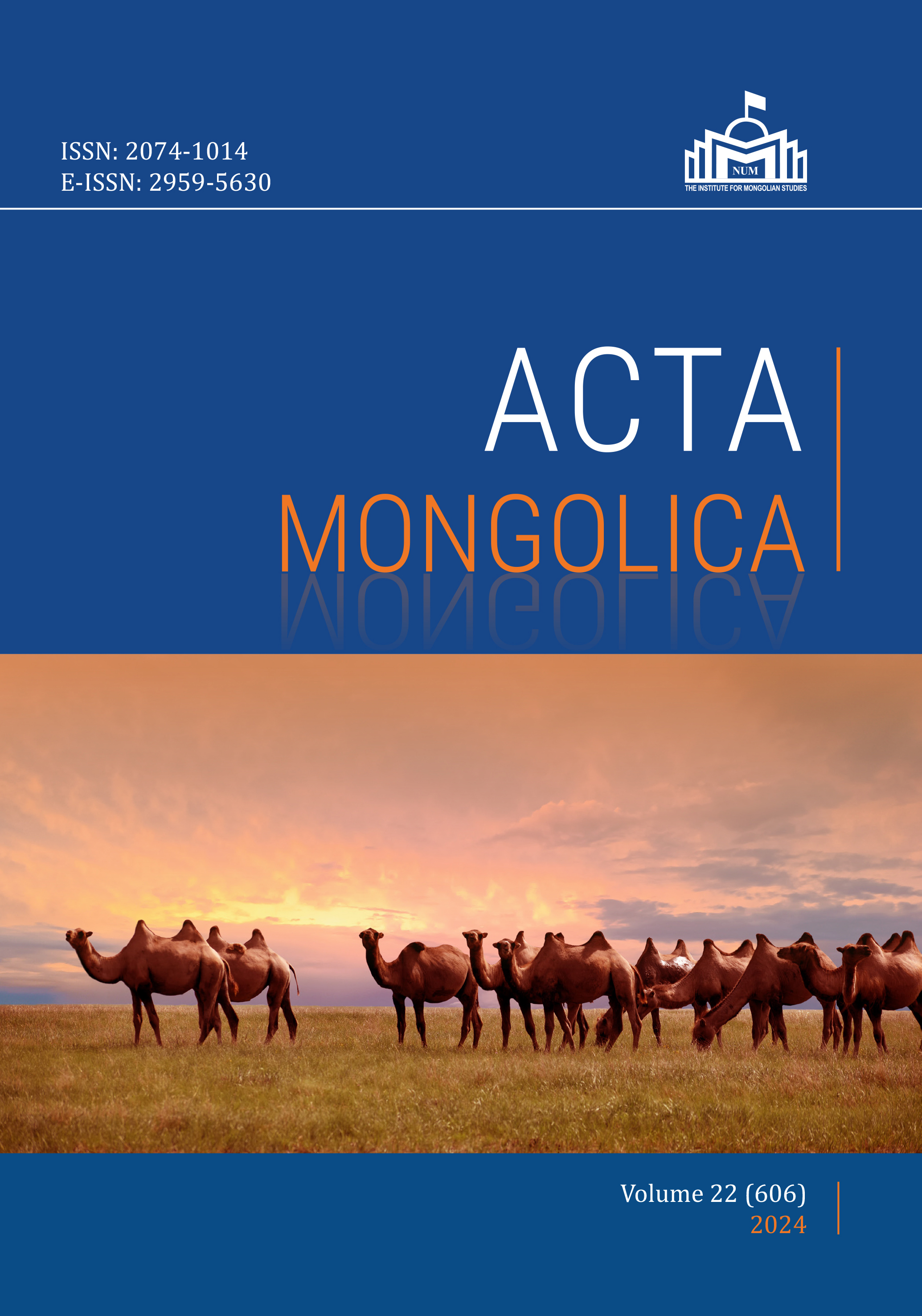Contiguity Theory and the word order of reduced nominals in Mongolian
Main Article Content
Abstract
This paper discusses the word order properties of object nouns and adverbs in Mongolian. As is well known, the accusative case marker appears only sometimes on the object. I review Guntsetseg’s (2016) in depth discussion on differential object marking and pseudo noun incorporation in Mongolian and present some prior work on the prosody of these two constructions (Barrie and Kang, 2022). I show that a caseless non-specific object can be separated from the verb by at most a low VP-adverb. A case-marked or specific, caseless object cannot appear between the verb and a low VP-adverb. Furthermore, a case-marked or specific, caseless object can appear above a higher, temporal adverb, but a caseless, non-specific object cannot. I analyze these facts within a Contiguity Theoretic framework (Richards, 2016) starting with the premise that a caseless non-specific object is an nP and that case-marked or caseless, specific object is a full KP. I argue that an nP object must be contiguity prominent with its selector, the verb, only and that a KP object must be contiguity prominent first with the verb and then with v, which assigns it accusative Case. I show that maintaining contiguity prominence gives rise to the patterns discussed.
Article Details

This work is licensed under a Creative Commons Attribution-ShareAlike 4.0 International License.
References
Baker, Mark C. 1988. Incorporation: A Theory of Grammatical Function Changing. Chicago, IL: University of Chicago Press.
Baker, Mark C. 2014. Pseudo Noun Incorporation as Covert Incorporation: Linearization and Crosslinguistic Variation. Language and Linguistics 15. 5–46.
Barrie, Michael & Kang, Jungu. 2022. The Syntax and Prosody of DOM and PNI in Mongolian. Studies in Generative Grammar 32(3). 405–424.
Bošković, Željko. 2016. What is sent to spell-out is phases, not phasal complements. Linguistica 56(1). 25–66. DOI: https://doi.org/10.4312/linguistica.56.1.25-66
Bossong, Georg. 1991. Differential Object Marking in Romance and Beyond. In Dieter Wanner & Douglas A. Kibbee (eds.), New Analyses in Romance Linguistics: Selected papers from the Linguistic Symposium on Romance Languages XVIII, Urbana-Champaign, April 7–9, 1988, 143–170. Amsterdam: John Benjamins Publishing Company.
Branan, Kenyon Garrett. 2018. Relationship preservation. Cambridge, MA: MIT dissertation.
Chomsky, Noam. 2001. Derivation by Phase. In Michael Kenstowicz (ed.), Ken Hale: A Life in Language, 1–52. Cambridge, MA: MIT Press.
Clemens, Lauren Eby. 2019. Prosodic Noun Incorporation: The Relationship between Prosody and Argument Structure in Niuean. Syntax 22(4). 337–377.
Compton, Richard & Pittman, Christine. 2010. Word formation by phase in Inuit. Lingua 120(9). 2167–2192.
Dayal, Veneeta. 2011. Hindi Pseudo-Incorporation. Natural Language & Linguistic Theory 29(1). 123–167.
Dayal, Veneeta. 2015. Incorporation: Morpho-Syntactic vs. Semantic Considerations. Syntax and Semantics 40. 47–87.
Diesing, Molly. 1992. Indefinites. Cambridge: MIT Press.
Driemel, Imke. 2023. Pseudo-Noun Incorporation and Differential Object Marking. Oxford: Oxford University Press.
Elfner, Emily. 2015. Recursion in prosodic phrasing: evidence from Connemara Irish. Natural Language & Linguistic Theory 33(4). 1169–1208.
Fábregas, Antonio. 2013. Differential Object Marking in Spanish: state of the art. Borealis. Int. J. Hisp. Linguist. 2. 1–80. DOI: https://doi.org/10.7557/1.2.2.2603
Fox, Danny & Pesetsky, David. 2005. Cyclic Linearization of Syntactic Structure. Theoretical Linguistics 31(1–2). 1–46.
Guntsetseg, Dolgor. 2016. Differential Case Marking in Mongolian. Harrassowitz Verlag.
Harley, Heidi. 2013. External arguments and the Mirror Principle: On the distinctness of Voice and v. Lingua 125(1). 34–57.
Ishihara, Shinichiro. 2022. On the (lack of) correspondence between syntactic clauses and international phrases. In Haruo Kubozono & Junko Ito & Armin Mester (eds.), Prosody and Prosodic Interfaces, 420–456. Oxford, England: Oxford University Press.
Janhunen, Juha A. 2012. Mongolian. Amsterdam: John Benjamins Publishing Company.
Kahnemuyipour, Arsalan. 2004. The Syntax of Sentential Stress. Toronto: University of Toronto dissertation.
Kandybowicz, J. 2020. Anti-Contiguity: A Theory of Wh- Prosody. Oxford: Oxford University Press.
Kang, Jungu. 2023. Reduced nominal structure in Uzbek and Mongolian. Sogang University dissertation.
Karlsson, Anastasia. 2014. The intonational phonology of Mongolian. In Jun Sun-Ah (ed.), Prosodic Typology II: The Phonology of Intonation and Phrasing, 187–215. Oxford: Oxford University Press. Retrieved from http://dx.doi.org/10.1093/acprof:oso/9780199567300.003.0007
Kratzer, Angelika & Selkirk, Elisabeth. 2007. Phase theory and prosodic spellout: The case of verbs. The Linguistic Review 24(1). 93–135.
Legate, Julie Anne. 2014. Voice and v: Lessons from Acehnese. Cambridge, MA: MIT Press.
Levin, Theodore. 2015. Licensing without Case. Cambridge, MA: MIT dissertation.
Lidz, Jeffrey. 2006. The grammar of accusative case in Kannada. Language 82(1). 10–32.
López, Luis. 2012. Indefinite Objects: Scrambling, Choice Functions, and Differential Marking. Cambridge, MA: MIT Press.
Massam, Diane. 2001. Pseudo Noun Incorporation in Niuean. Natural Language & Linguistic Theory 19(1). 153–197.
Newell, Heather. 2008. Aspects of the Morphology and Phonology of Phases. Montreal, QC: McGill University dissertation.
Newell, Heather & Piggott, Glyne. 2014. Interactions at the syntax–phonology interface: Evidence from Ojibwe. Lingua 150. 332–362. DOI: https://doi.org/10.1016/j.lingua.2014.07.020
Nunes, Jairo. 2004. Linearization of Chains and Sideward Movement. Cambridge, MA: MIT Press.
Richards, Norvin. 2016. Contiguity Theory. Cambridge, MA: MIT Press.
Seiter, William. 1980. Studies in Niuean Syntax. New York, NY: Garland.
Selkirk, Elisabeth. 2009. On clause and intonational phrase in Japanese: the syntactic grounding of prosodic constituent structure. Gengo Kenkyu 136. 35–75.
Selkirk, Elisabeth. 2011. The syntax-phonology interface. In John Goldsmith & Jason Riggle & Alan Yu (eds.), The Handbook of Phonological Theory, 435–484. West Sussex: Wiley-Blackwell.
Svantesson, Jan-Olof & Tsendina, Anna & Karlsson, Anastasia & Franzen, Vivian. 2005. The Phonology of Mongolian. Oxford: Oxford University Press.
Weber, Natalie. 2020. Syntax, prosody, and metrical structure in Blackfoot. University of British Columbia dissertation.
Weber, Natalie. 2021. Phase-based constraints within Match Theory. In Ryan Bennett & Richard Bibbs & Mykel Loren Brinkerhoff & Max J. Kaplan & Stephanie Rich & Amanda Rysling & … Maya
Wax Cavallaro (eds.), Supplemental Proceedings of the 2020 Annual Meeting on Phonology,. Washington, D.C: Linguistic Society of America. DOI: http://journals.linguisticsociety.org/proceedings/index.php/amphonology/index

